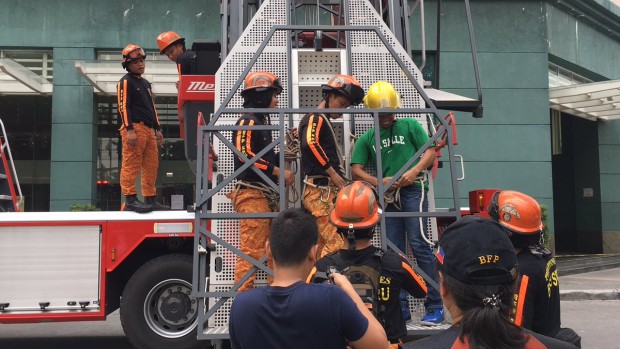
Members of the Bureau of Fire and Protection in Makati City use a high ladder to simulate a rescue operation in case the “Big One” strikes. YUJI VINCENT GONZALES/INQUIRER.net
Thousands participated on Wednesday in the nationwide earthquake drill, an exercise that aims to teach what to do when a powerful quake hits Metro Manila.
Camp Aguinaldo, the military’s main headquarters located in Quezon City, served as the ceremonial venue and the national command post.
At 9 a.m., sirens blared to signal the start of the 7.2 magnitude earthquake. Participants ducked for cover and later evacuated to open grounds after the shaking supposedly stopped. The drill set different scenarios and challenges to test the emergency plans.
“Metro Manila is the seat of power. Millions of people are here and if such large earthquake will affect Manila, the whole Philippines will be affected. So we need to be serious and I’m very glad through the leadership (of the National Disaster Risk Reduction and Management Council [NDRRMC] and the Metro Manila Development Authority), the drill is quite a success, and it not only because of us but everyone here,” Philippine Institute of Volcanology and Seismology Director Renato Solidum said at Camp Aguinaldo at the end of the earthquake drill.
READ: Metro Manila, nearby provinces brace for ‘big one’ with shake drill
Communications tower was set up at the military’s main camp as regular communication lines were supposed to be destroyed by the quake.
Members of the NDRRMC response cluster also gathered at Camp Aguinaldo to assess the initial amount of damage and the kind of response needed.
“It was a success in the context na nakuha natin ‘yung objective for this exercise; primarily one, awareness ng mga kababayan natin, partisipasyon ng kababayan natin. Then number two, ‘yung sistema na gusto naming praktisin ay nagawa natin, at yung pakikipagtungo at partisipasyon ng ating mga kababayan at ahensya ng gobyerno natin,” said NDRRMC Executive Director Alexander Pama.
(It was a success in the context that we achieved the objective for this exercise; primarily one, awareness and participation of the public. Then number two, the system that we wanted to practice was done, and the treatment and participation of the public and the agencies of the government.)
The movement of the West Valley Fault that could generate the massive earthquake runs through parts of Metro Manila and nearby provinces. Based on the Metro Manila Earthquake Impact Reduction Study and the GMMA-Ready Project, a 7.2 earthquake is the worst case scenario for Metro Manila and nearby provinces.
Based on historical data, a powerful quake could hit Manila anytime within the next 50 years. JE
RELATED STORIES
‘Hohum’ — Congress during shake drill
Duck, cover, hold! Take 2 for Shake Drill at 9 a.m. today
RELATED VIDEOS